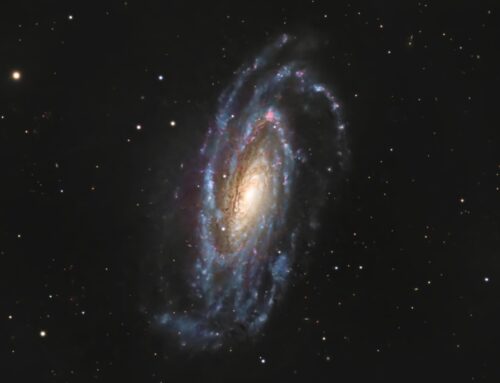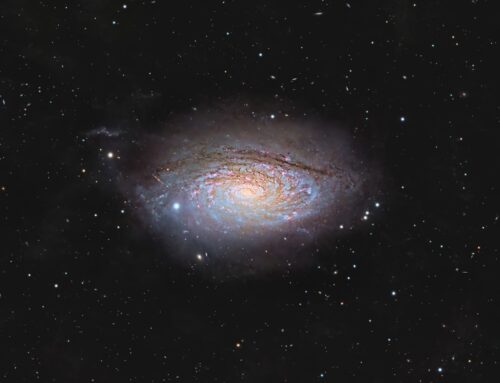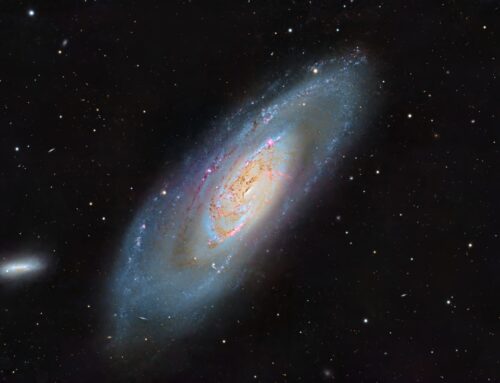M57, The Ring Nebula
Click image for full size version
August 26, 2012
M57, the Ring Nebula, is one of the first things I looked at visually when I became interested in astronomy. It looked like a cosmic smoke ring in my first decent scope, an 8″ Schmidt-Cassegrain. There are two stars inside the ring that I have seen distinctly only once using my 20″ reflector, and indistinctly just a few times. And yet the brightest part of the ring makes it pretty easy in binoculars (except that it’s small). So bottom line is it’s good with just about any kind of optical aid. Images capture the pretty colours of the nebula and the surrounding stars, and deep images with special filters can capture the faint ruffled outer shell. If you have binoculars or a scope, this object is well placed in the evening just after dark, high in the northeast, smack-dab between two bright stars in Lyra. One of these stars is Sheliak, which will be well know to Star Trek Buffs. See http://en.memory-alpha.org/wiki/Sheliak to find ouit more about the brutish Sheliak people and their home world.
This planetary nebula is the glowing shell of a dying star, the star in the centre of the ring. The red is mostly from glowing hydrogen atoms, the blue-green is mostly from glowing oxygen atoms. Nebulae gradually expand and dissipate. Photos of M57 over the last 50 years confirm that it is expanding. When your great-treat-great-great-great-grandchildren look at it, it will be quite a bit bigger and a lot fainter!
Tekkies:
SBIG STL-11000M camera, Baader LRGB filters, 10″ f/6.8 ASA astrograph, MI-250 mount. Guided with STL-11000’s internal guider. Acquistion, guiding, calibration, registration and integration all done using Maxim-DL. All other processing in PixInsight. Shot from my SkyShed in Guelph, Ontario. Nearly first quarter moon. Average transparency and below average seeing.
5x3m R,G and B for a total of 45 min RGB. 6x10m Ha for a total of 1 hr Ha. Total exposure time was 1 hr 45m.
The RGB and Ha files produced in MaximDL were cleaned up in PixInsight with DynamicBackgroundExtraction, and then registered and cropped. The HaRGBCombine script was then used to combine Ha and RGB images. The HaRGB image was processed as follows: Colour calibration was applied followed by deconvolution, histogram stretch, ACDNR (small scale), histogram stretch. At this point, I wanted to bring back the blue-green centre of the nebula without losing the faint red outer shell. I made a mask from the RGB shot and then blurred it a little. Then I stretched the RGB image so it could be combined with the HaRGB using PixelMath. I used PixelMath to to replace the HaRGB with RGB only in the central part of the nebula. Image scale is about 1.1 arcsec per pixel for this camera / telescope combination.







FABULOUS PHOTOGRAPH! I needed an Art class in college, so I took photography in hopes of using it on a telescope. Life happened, and astrophotography didn’t. I allowed myself to get TOO BUSY! Life has been very good to me in many other ways.